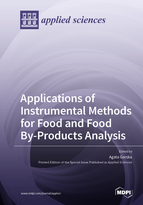Applications of Instrumental Methods for Food and Food By-Products Analysis
A special issue of Applied Sciences (ISSN 2076-3417). This special issue belongs to the section "Food Science and Technology".
Deadline for manuscript submissions: closed (15 January 2022) | Viewed by 34661
Special Issue Editor
Interests: food chemistry; food byproduct analysis; protein chemistry; carbohydrate chemistry; fat chemistry; methods of bioactive component extraction from food and food byproducts; thermal analysis of food products
Special Issues, Collections and Topics in MDPI journals
Special Issue Information
Dear Colleagues,
Food and food byproduct analysis is a particularly important topic dealing with the development and application of various analytical procedures and methods determining the properties and safety of food and food constituents. It is an important tool not only for defining food quality but also for supporting the investigation of new food products and technologies. The continuous development of methodology and access to modern research equipment enable detailed research on the composition, structure, physicochemical properties, thermal characteristics, and stability of food products, and recently also byproducts of the food industry. Agro-industrial residues currently present little commercial value and are mostly disposed of as an industrial waste. Taking the aforementioned reasons into account, it is imperative to identify properties and potential applications of food by-products, which would fit in with current trends in circular ecology. The objective of this Special Issue is to present procedures and instrumental analytical techniques and methods commonly used to analyze food and food processing byproducts and to discuss their application in food research to detect and characterize specific food components of significance to food science and technology, such as lipids, proteins, and carbohydrates.
Suggested research problems include but are not limited to the following topics:
- Analysis of composition and structure of food and food byproducts using instrumental methods;
- Characteristics of physicochemical properties of food and food byproducts;
- Application of modern thermal techniques to study properties of food, specific food components, and processing byproducts of the food industry;
- Stability, including oxidative stability of food and food byproducts;
- Analysis of food processing byproducts as a source of bioactive substances;
- Application of various extraction techniques assisted by modern methods to isolate bioactive components from food processing byproducts.
Prof. Dr. Agata Górska
Guest Editor
Manuscript Submission Information
Manuscripts should be submitted online at www.mdpi.com by registering and logging in to this website. Once you are registered, click here to go to the submission form. Manuscripts can be submitted until the deadline. All submissions that pass pre-check are peer-reviewed. Accepted papers will be published continuously in the journal (as soon as accepted) and will be listed together on the special issue website. Research articles, review articles as well as short communications are invited. For planned papers, a title and short abstract (about 100 words) can be sent to the Editorial Office for announcement on this website.
Submitted manuscripts should not have been published previously, nor be under consideration for publication elsewhere (except conference proceedings papers). All manuscripts are thoroughly refereed through a single-blind peer-review process. A guide for authors and other relevant information for submission of manuscripts is available on the Instructions for Authors page. Applied Sciences is an international peer-reviewed open access semimonthly journal published by MDPI.
Please visit the Instructions for Authors page before submitting a manuscript. The Article Processing Charge (APC) for publication in this open access journal is 2400 CHF (Swiss Francs). Submitted papers should be well formatted and use good English. Authors may use MDPI's English editing service prior to publication or during author revisions.
Keywords
- food by-products
- composition and structure
- instrumental methods
- modern thermal techniques
- oxidative stability
- food processing






